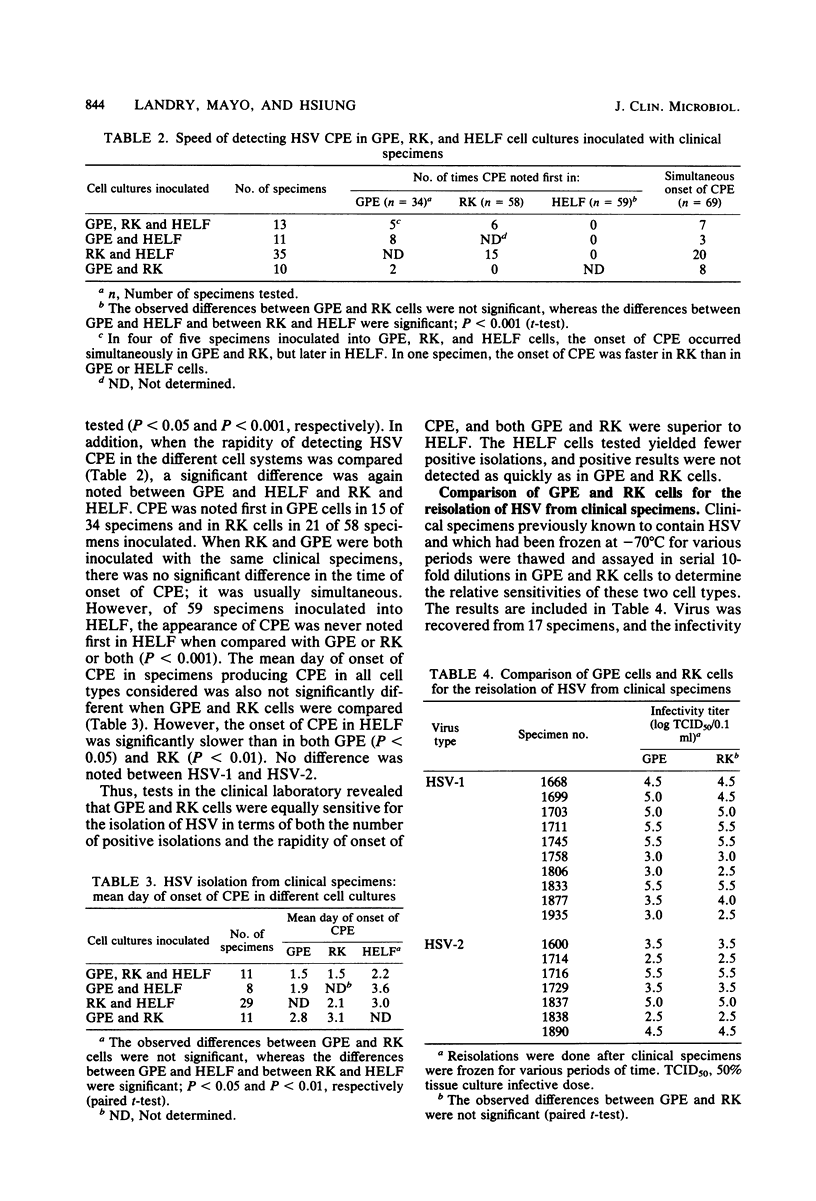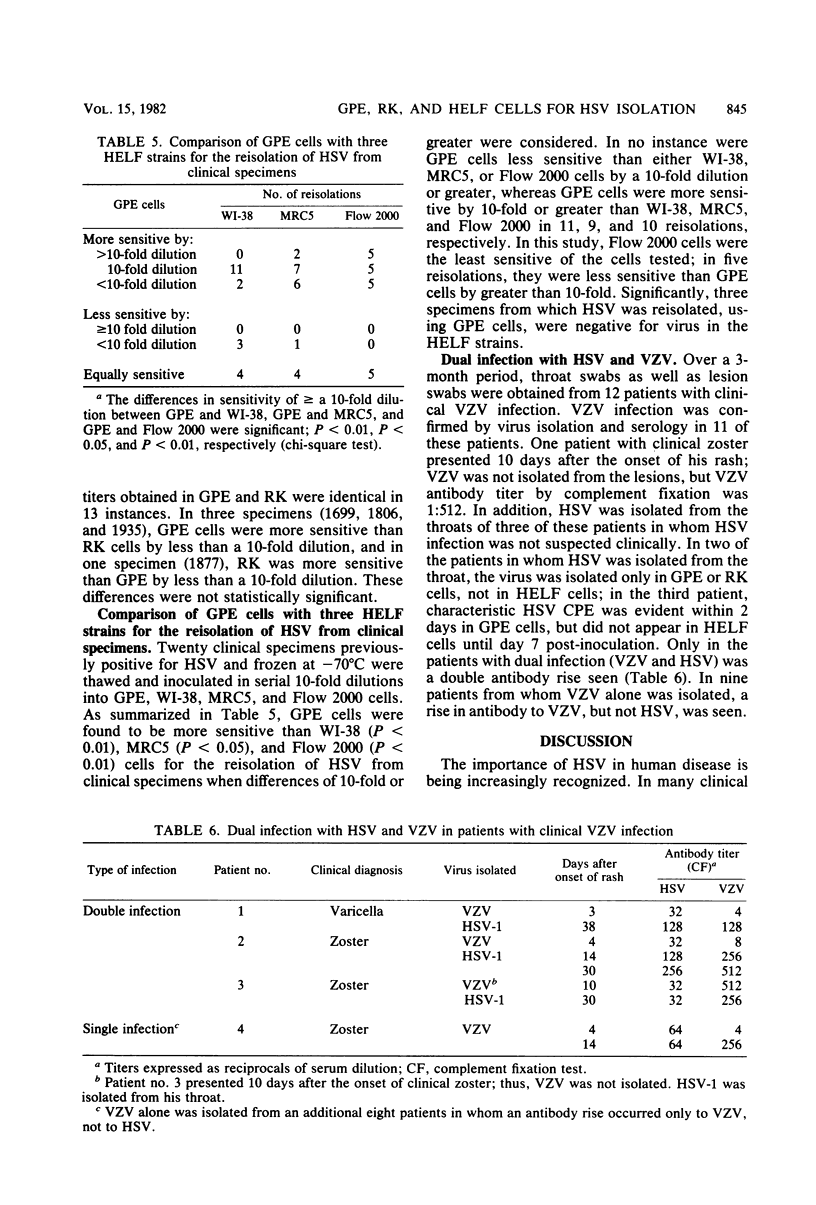Abstract
With the recognition of the importance and the prevalence of herpes simplex virus infections and the availability of effective chemotherapy, there has come a demand for rapid, sensitive, and accurate diagnosis. Virus isolation in cell culture remains the most widely employed diagnostic method, and the cell cultures used vary greatly from laboratory to laboratory. Therefore, a study was undertaken to compare several commonly employed human fibroblast cell strains and two nonhuman cells, primary rabbit kidney and guinea pig embryo cells, for the primary isolation of this virus. Our experience in the isolation of herpes simplex virus in the clinical laboratory with these cell systems was evaluated, and reisolations from clinical specimens were performed. We found that guinea pig embryo and rabbit kidney cell cultures were equally sensitive for the isolation of herpes simplex virus from clinical specimens and were superior to the human embryonic lung fibroblast cell strains tested in terms of both sensitivity and rapidity of appearance of cytopathic effect. The use of guinea pig embryo cells for the isolation of this virus from clinical specimens has not been previously reported.
Full text
PDF





Selected References
These references are in PubMed. This may not be the complete list of references from this article.
- Anderson C. A., August M. J., Hsiung G. D. Pathogenicity of wild-type and temperature-sensitive mutants of herpes simplex virus type 2 in guinea pigs. Infect Immun. 1980 Oct;30(1):159–169. doi: 10.1128/iai.30.1.159-169.1980. [DOI] [PMC free article] [PubMed] [Google Scholar]
- Douglas R. G., Jr, Couch R. B. A prospective study of chronic herpes simplex virus infection and recurrent herpes labialis in humans. J Immunol. 1970 Feb;104(2):289–295. [PubMed] [Google Scholar]
- HSIUNG G. D., PINHEIRO F., GABRIELSON M. O. THE VIRUS DIAGNOSTIC LABORATORY: FUNCTIONS AND PROBLEMS BASED ON THREE YEARS' EXPERIENCE. Yale J Biol Med. 1963 Aug;36:104–123. [PMC free article] [PubMed] [Google Scholar]
- Johnson R. T., Olson L. C., Buescher E. L. Herpes simplex virus infections of the nervous system. Problems in laboratory diagnosis. Arch Neurol. 1968 Mar;18(3):260–264. doi: 10.1001/archneur.1968.00470330050004. [DOI] [PubMed] [Google Scholar]
- Landry M. L., Madore H. P., Fong C. K., Hsiung G. D. Use of guinea pig embryo cell cultures for isolation and propagation of group A coxsackieviruses. J Clin Microbiol. 1981 Mar;13(3):588–593. doi: 10.1128/jcm.13.3.588-593.1981. [DOI] [PMC free article] [PubMed] [Google Scholar]
- Muller S. A., Herrmann E. C., Jr, Winkelmann R. K. Herpes simplex infections in hematologic malignancies. Am J Med. 1972 Jan;52(1):102–114. doi: 10.1016/0002-9343(72)90012-5. [DOI] [PubMed] [Google Scholar]
- Rawls W. E., Tompkins W. A., Melnick J. L. The association of herpesvirus type 2 and carcinoma of the uterine cervix. Am J Epidemiol. 1969 May;89(5):547–554. doi: 10.1093/oxfordjournals.aje.a120967. [DOI] [PubMed] [Google Scholar]
- Schaap G. J., Huisman J. Simultaneous rise in complement-fixing antibodies against herpesvirus hominis and varicella-zostervirus in patients with chickenpox and shingles. Arch Gesamte Virusforsch. 1968;25(1):52–57. doi: 10.1007/BF01243089. [DOI] [PubMed] [Google Scholar]
- Whitley R. J., Nahmias A. J., Soong S. J., Galasso G. G., Fleming C. L., Alford C. A. Vidarabine therapy of neonatal herpes simplex virus infection. Pediatrics. 1980 Oct;66(4):495–501. [PubMed] [Google Scholar]
- Whitley R. J., Soong S. J., Hirsch M. S., Karchmer A. W., Dolin R., Galasso G., Dunnick J. K., Alford C. A. Herpes simplex encephalitis: vidarabine therapy and diagnostic problems. N Engl J Med. 1981 Feb 5;304(6):313–318. doi: 10.1056/NEJM198102053040602. [DOI] [PubMed] [Google Scholar]


